The Term describes the Continual Source of an Infection
Introduction [edit | edit source]
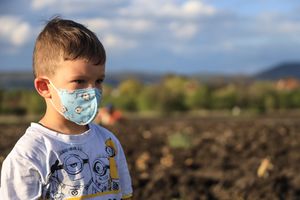
Infectious diseases are spread by either bacterial or viral agents and are ever-present in society. Usually infected cases are present in numbers below an expected thresholdA but every once in a while there may be an outbreak, a new strain or a new disease that has a significant impact at either a local or global level[1]. The spread and rate of new cases can be classified as[1]:
- Endemic - describes a disease that is present permanently in a region or population
- Epidemic - is an outbreak that affects many people at one time and can spread through one or several communities
- Pandemic - is the term used to describe an epidemic when the spread is global.
Endemic [edit | edit source]
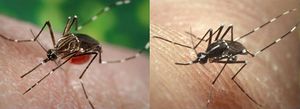
Endemic is derived from Greek en meaning in and demos meaning people. It is used to describe a disease that is present at an approximately constant level within a society or country. Each country may have a disease that is unique, for example
- Caribbean Dengue is still present due to a failure to eradicate the Aedes aegypti mosquito (see image R). Dengue first appeared in the Americas and the Caribbean and with the assistance of the Pan American Health Organisation (PAHO) in the 1950s and 1960s the Americas were largely able to eradicate the presence of the Aedes Aegypti virtually eliminating the occurrence of Dengue[2]. However, failure to eradicate its presence in the Caribbean resulted in the continued transmission throughout the region and more recently it has found its way back into the Americas causing several epidemics[2].
- Varicella, more commonly known as chickenpox in the UK. It is more common in children under the age of 10, who often only experience mild symptoms and after exposure develop a natural immunity to the virus. Although there is a vaccine available it is only offered to those who are seen as vulnerable.[3]
- Malaria is another infectious disease that is endemic to Africa; through education and implementing countrywide strategies the cases of Malaria are now falling (see video below)
[4]
Epidemic [edit | edit source]
An epidemic is derived from Greek epi meaning upon or above and demos meaning people and is the term used to describe a situation where a disease spreads rapidly to a large number of people in a given population over a short time period.
The term epidemic is not just used with infectious diseases. It is also used with any scenario that leads to a detrimental rise of health risks within a society. eg.
- The rise in obesity globally (often described as an "obesity epidemic"). Over the last 3 decades, the United States has seen an increase in the number of people who have a BMI higher than the recommended average[5].
When the term epidemic is used in connection with infectious diseases it is due to the sudden rise of cases usually resulting from a new infectious agent or a change in an existing agent, for example:
- An agent moving between host populations, for example moving from animals to humans (zoonotic diseases)[6]
- A genetic change (mutation) in the infectious agent, eg bacteria, virus, fungi or parasite
- Introduction of new pathogens to a host population[7]
Epidemics can follow predictable patterns and these trends are often used to monitor, predict and control the spread of the infection. A typical example of this is seasonal flu.
[8]
Pandemic [edit | edit source]
A pandemic is derived from Greek pan meaning all and demos meaning people and is the term used to describe the rapid spread of a transmissible infectious/communicable disease over several continents or worldwide. Once an epidemic becomes global and affects a large percent of the population it becomes known as a pandemic. The terms pandemic and epidemic are used to describe the rate and distance of the spread of the disease and not the severity of the disease. Significant features of a pandemic are listed below:
- Affects a wider geographical area, often global
- Infects a very large number of people
- Often caused by a new virus or a new strain of a virus that has been dormant for many years.
- Spreads quickly in humans as there is little to no existing immunity
- Can cause a high number of deaths
- Because of the need to control the spread of the disease, there is often social disruption, unrest and economic loss
Escalation of an Epidemic to a Pandemic [edit | edit source]
The World Health Organization (WHO) will declare a Pandemic when a disease has shown exponential growth - dramatically increasing rate of growth, each day showing many more cases than the previous day. A current example of this is the Coronavirus Disease (COVID-19). On 31 December 2019, a cluster of cases of pneumonia of unknown cause, in the city of Wuhan, Hubei province in China, was reported to the WHO. This was subsequently identified as a new virus in January 2020 and over the following months, the number of cases continued to rise but were not contained to China and showed exponential growth worldwide. Due to the rapid global rise in cases, this was declared a pandemic on 11 March[9] and globally, as of 4:22pm CET, 9 December 2020, there have been 67,780,361 confirmed cases of COVID-19, including 1,551,214 deaths, reported to WHO.s[10]
Stages of a Pandemic [edit | edit source]
The WHO has identified six phases that it follows before declaring a pandemic[11]. Phase 1 represents a low risk and phase 6 is a full-blown pandemic, you can see the phases below:
- Phase 1 - a virus is seen in animals but has not been shown to infections in humans
- Phase 2 - a known animal virus has caused an infection in humans
- Phase 3 - scattered or isolated incidence of cases or small clusters of the disease occurring in humans; possible cases of human-to-human transmission but not at a level to cause community-level outbreaks
- Phase 4 - human to human transmission at a rate that causes an outbreak in communities
- Phase 5 - the spread of the disease between humans is now evident in more than one country
- Phase 6 - community-level outbreaks are in at least one additional country other than that seen in phase 5.
Once Phase 6 is reached preparation is then made for a global pandemic. Each phase has a list of actions that need to be followed to facilitate transparency and the education of health organisations and members of the public. The table below describes these actions.
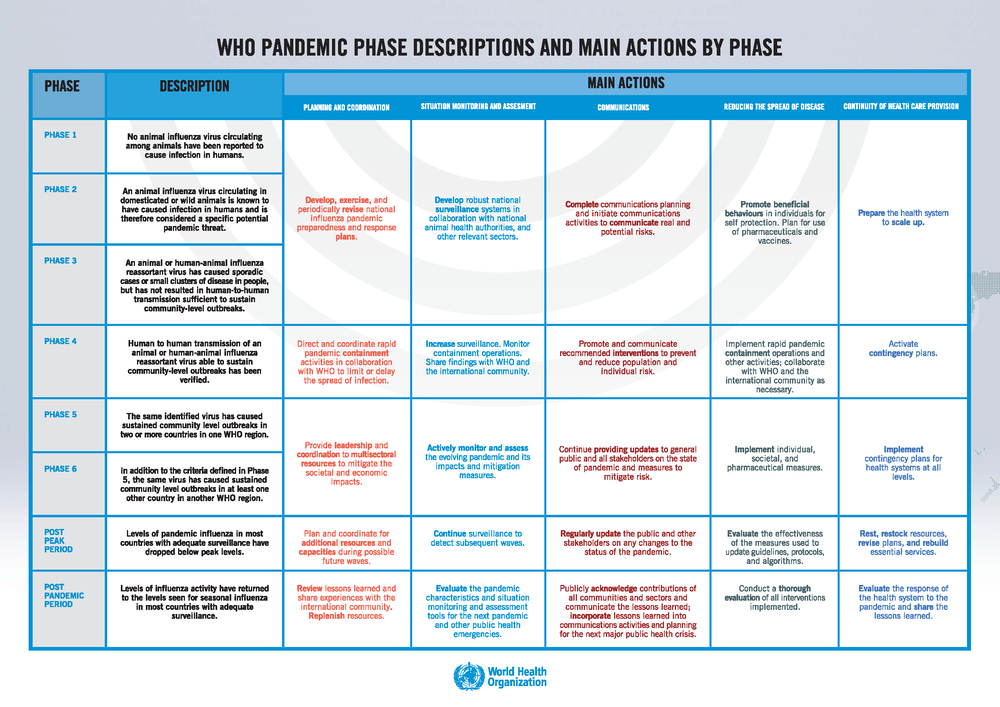
Preventing a Pandemic [edit | edit source]

It is important to try to prevent an epidemic from developing into a pandemic. This requires organisations and nations to act early and be prepared. A set of policies to try to limit the spread of an infectious agent beyond the initial individual cases and small clusters of infection are termed Containment. There are several measures that have proven effective in the control and containment of viruses[12]:
- Controls - application of border controls to limit/prevent movement of individuals to and from affected areas
- Identify cases - educate the public on the symptoms and risk factors, provide easy access to testing, flag potential cases in any healthcare encounters, track contact with infected individuals
- Trace contacts - a labour-intensive process which tracks an infected individual's movements from the moment of infection to identify all individuals who have been potentially infected.
- Quarantine - separate an individual suspected of infection from contact with others for a certain period of time that covers the period of incubation for the disease
- Isolate - separate an individual who has been identified as infected from contact with others
- Protect - use appropriate equipment to protect healthcarew(PPE)orkers who cannot avoid contact with infected individuals.
Summarised by Tomas Pueyo as "very quickly limit people coming in, identify the sick, immediately isolate them, use heavy protective gear to protect their health workers, track all their contacts, quarantine them…" [13]
Managing a Pandemic [edit | edit source]
Once a pandemic is identified it is vital to take the appropriate action to contain, manage and reduce the spread of the virus. The key message at this stage is to reduce the transmission rate - the number of individuals infected by each single infected individual. If on average across a population the transmission rate is greater than one the number of cases will continue to increase. Measures that reduce the transmission rate to less than one will result in a decline in the total number of infections.
Once a significant level of infection is present within a population then reducing this rate of spread becomes vital. Actions targeted at reducing the transmission rate are termed Mitigation and can involve:
- Social distancing (cancel events, closing institutions, work from home etc.)
- Education of the public - to promote actions such as hand washing and avoiding groups etc.
- Economic measures - to provide relief to individuals and businesses and to increase compliance with social distancing related policies
All these measures aim to limit the population exposed to infection and to reduce the transmission rate between them. This results in a flattening of the curve of cases over time (see figures below) and so reducing the peak in the number of cases needing medical care. This maintains the ability of the healthcare system to provide quality care to those affected and reduce the mortality rate as far as possible. The greater the stress on the healthcare system the higher the likely mortality rate, as resources are unable to meet the demand and healthcare workers themselves exceed their capacity to provide care. Flattening the curve also extends the time scale of the epidemic so that any potential vaccine can at some future point be used to rapidly increase immunity within the population.
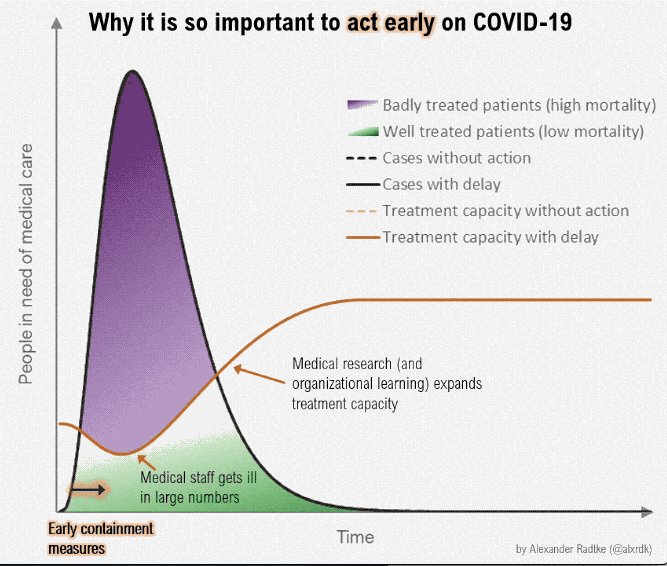
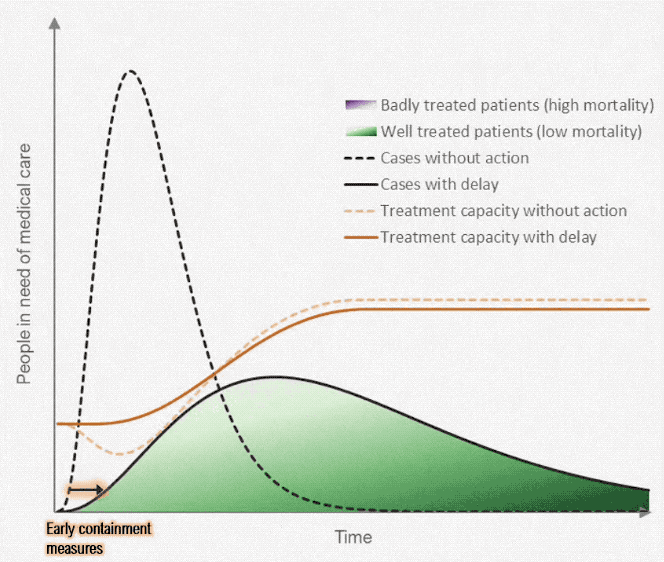
References [edit | edit source]
- ↑ 1.0 1.1 US Department of Health and Human Services. Principles of Epidemiology in Public Health Practice Third Edition An Introduction to Applied Epidemiology and Biostatistics. Accessed 15 March 2020
- ↑ 2.0 2.1 Brandling-Bennett AD, Penheiro F. Infectious diseases in Latin America and the Caribbean: are they really emerging and increasing?. Emerging infectious diseases. 1996 Jan;2(1):59.
- ↑ Chickenpox vaccine overview. NHS Website. Accessed 15 March 2020
- ↑ WHO: Global malaria progress and challenges in 2016. Available from:https://youtu.be/x74I-4BZnRo . Accessed 15 March 2020
- ↑ Mitchell NS, Catenacci VA, Wyatt HR, Hill JO. Obesity: overview of an epidemic. Psychiatric Clinics. 2011 Dec 1;34(4):717-32.
- ↑ Engering A, Hogerwerf L, Slingenbergh J. Pathogen–host–environment interplay and disease emergence. Emerging microbes & infections. 2013 Jan 1;2(1):1-7.
- ↑ National Institutes of Health. Understanding emerging and re-emerging infectious diseases. Biological sciences curriculum study. NIH Curriculum Supplement Series. National Institutes of Health, Bethesda, MD. 2007.
- ↑ Epidemics, Outbreaks and Pandemics. https://youtu.be/CUl87kYHT3I. Accessed on 15 March 2020
- ↑ WHO declares the coronavirus outbreak a pandemic. STAT News. Accessed 15 March 2020
- ↑ WHO WHO Coronavirus Disease (COVID-19) Dashboard Available from: https://covid19.who.int/ (last accessed 10.12.2020)
- ↑ World Health Organization. Pandemic influenza preparedness and response: a WHO guidance document. Geneva: World Health Organization; 2009.
- ↑ Wang CJ, Ng CY, Brook RH. Response to COVID-19 in Taiwan: Big Data Analytics, New Technology, and Proactive Testing. JAMA. 2020 Mar 3.
- ↑ Tomas Peuyo, Coronavirus: Why You Must Act Now, Politicians, Community Leaders and Business Leaders: What Should You Do and When?, Medium, March 10 2020 (viewed March 16th 2020) https://medium.com/@tomaspueyo/coronavirus-act-today-or-people-will-die-f4d3d9cd99ca
johnstonsheas1990.blogspot.com
Source: https://www.physio-pedia.com/Endemics,_Epidemics_and_Pandemics
0 Response to "The Term describes the Continual Source of an Infection"
Postar um comentário